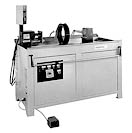Basic Test Theory
Magnetic particle inspection is a method that can be used to find surface and near surface flaws in ferromagnetic materials such as steel and iron.
The technique uses the principle that magnetic lines of force (flux) will be distorted by the presence of a flaw in a manner that will reveal it's presence. the flaw (for example, a crack) is located from the "flux leakage", following the application of fine iron particles, to the area under examination. There are variations in the way the magnetic field is applied but they are all dependant on the above principle .
The iron particles can be applied dry or wet; suspended in a liquid, colored or fluorescent. . But it's effectiveness quickly diminishes depending on the flaw depth and type.
Applications
Magnetic particle inspection is primarily used to find surface breaking flaws, it can also be used to locate sub-surface flaws. Applications include Interior macro scopic flaws - cracks, porosity,blow holes, non-metallic inclusions, incomplete root penetration,undercutting, icicles, and burn through.
Benefits of the Process
Relatively low-cost method.
Excellent fordetecting surface discontinuities - -especially surface cracks.
Simpler to use than radiographic inspection Permits controlled sensitivity.
Test method process is quick and simple in principle and application
Highly sensitive to the detection of surface and slightly subsurface linear indications
Indications appear on the actual test part
Test method process may often work through contaminant layers and coating thickness
The method lends itself to automation and high volume production inspection
Less expensive than other more sophisticated methods of quality assurance
Disadvantages/Limitations of the Process
Can only be used on ferrous materials.
Surface irregularities and scratches can give misleading indications. Therefore it is necessary to ensure careful preparation of the surface before magnetic particle testing is undertaken. .
Not generally suitable for fillet weld inspection.
Elongated defects parallel to the magnetic field may not give pattern; for this reason the field should be applied from two directions at or near right angles to each other.
Test material must be ferrous
Provides limited and variable potential for detection of subsurface indications
Care is required to avoid burning and arcing of test part surface at points of electrical contact
The magnetic field direction must intercept the major dimension of the discontinuity
Complex test part geometry may sometimes pose problems with proper amperage determination and magnetic field intensity
Demagnetization of test part following the inspection is often necessary
Equipment Needed
Special commercial equipment
Magnetic powders- - dry or wet form; may be fluorescent for viewing under ultraviolet light.
Workmanship Standards |

